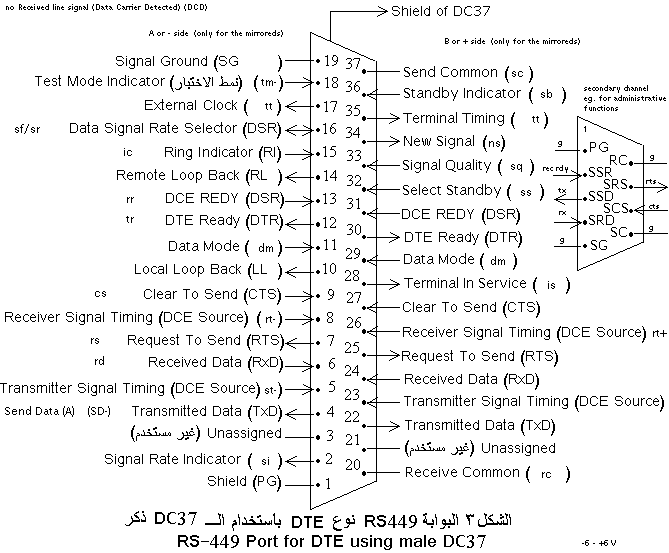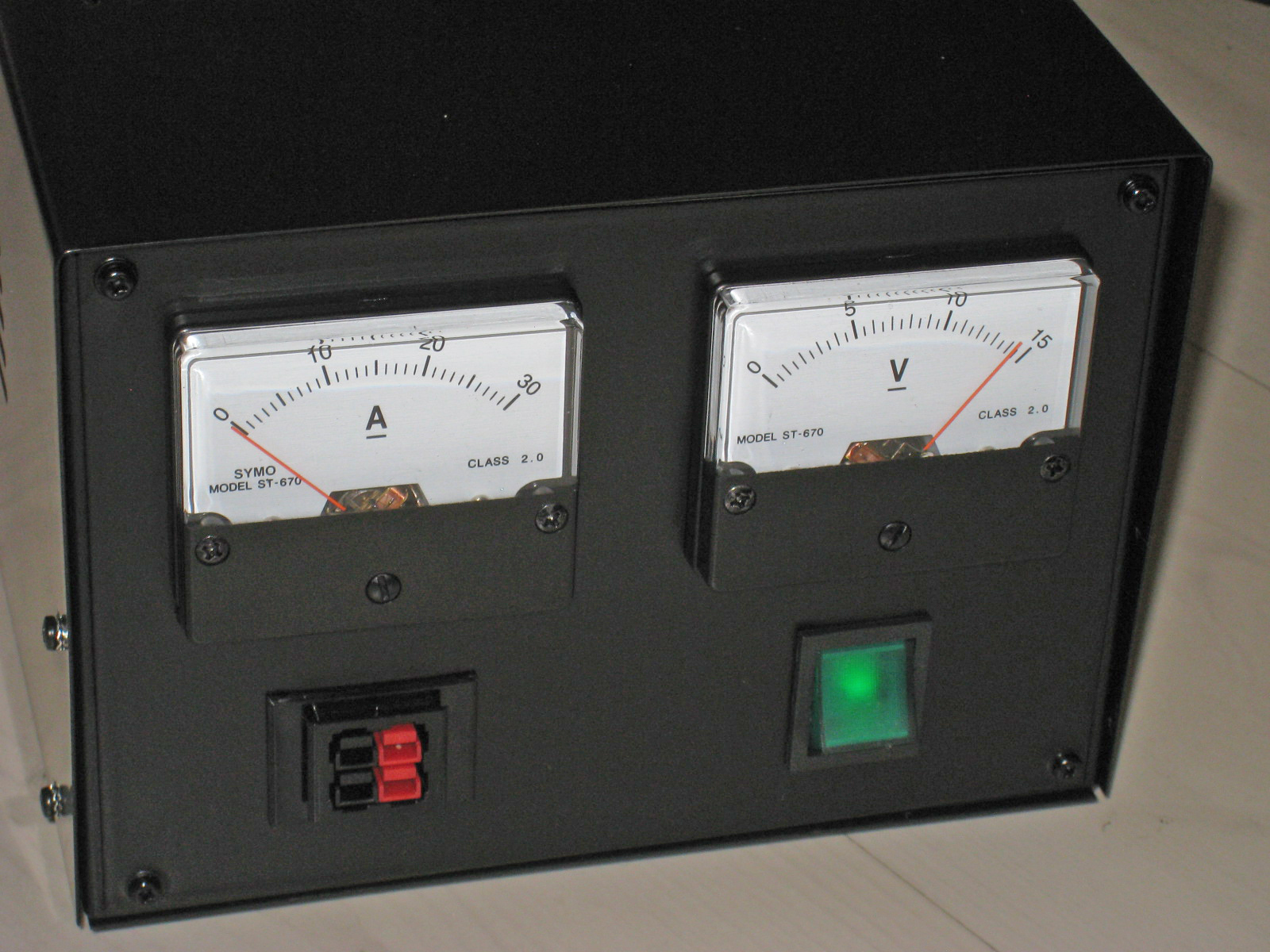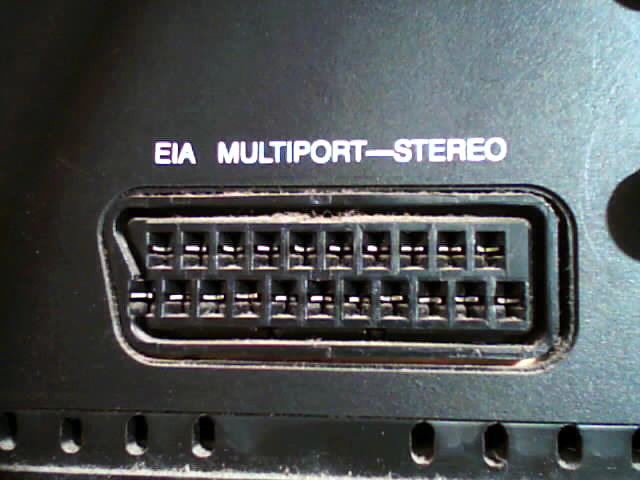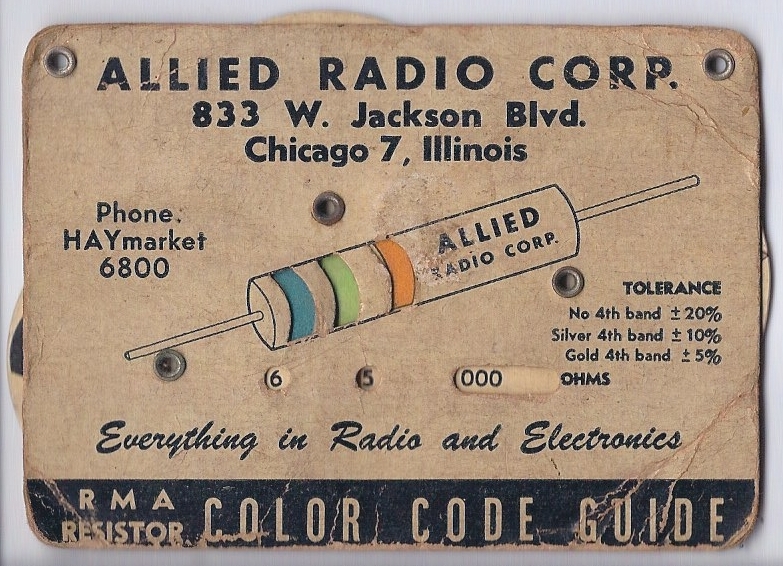|
EIA-449
The RS-449 specification, also known as EIA-449 or TIA-449, defines the functional and mechanical characteristics of the interface between data terminal equipment, typically a computer, and data communications equipment, typically a modem or terminal server. The full title of the standard is ''EIA-449 General Purpose 37-Position and 9-Position Interface for Data Terminal Equipment and Data Circuit-Terminating Equipment Employing Serial Binary Data Interchange''. 449 was part of an effort to replace RS-232C, offering much higher performance and longer cable lengths while using the same DB-25 connectors. This was initially split into two closely related efforts, RS-422 and RS-423. As feature creep set in, the number of required pins began to grow beyond what a DB-25 could handle, and the RS-449 effort started to define a new connector. 449 emerged as an unwieldy system using a large DC-37 connector along with a separate DE-9 connector if the 422 protocol was used. The resultin ... [...More Info...] [...Related Items...] OR: [Wikipedia] [Google] [Baidu] |
RS-423
RS-423, also known as TIA/EIA-423, is a technical standard originated by the Electronic Industries Alliance that specifies electrical characteristics of a digital signaling circuit. Although it was originally intended as a successor to RS-232C offering greater cable lengths, it is not widely used. RS-423 systems can transmit data on cables as long as . It is closely related to RS-422, which used the same signaling systems but on a different wiring arrangement: RS-423 differed primarily in that it had a single return pin instead of one for each data pin. RS-423 specifies an unbalanced ( single-ended) interface, similar to RS-232, with a single, unidirectional sending driver, and allowing for up to 10 receivers. It is normally implemented in integrated circuit technology and can also be employed for the interchange of serial binary signals between DTE & DCE. Standard scope RS-423 is the common short form title of American National Standards Institute (ANSI) standard ''ANSI/TIA ... [...More Info...] [...Related Items...] OR: [Wikipedia] [Google] [Baidu] |
RS-422
RS-422, also known as TIA/EIA-422, is a technical standard originated by the Electronic Industries Alliance, first issued in 1975, that specifies the electrical characteristics of a digital signaling circuit. It was meant to be the foundation of a suite of standards that would replace the older RS-232C standard with standards that offered much higher speed, better immunity from noise, and longer cable lengths. RS-422 systems can transmit data at rates as high as 10 Mbit/s, or may be sent on cables as long as at lower rates. It is closely related to RS-423, which uses the same signaling systems but on a different wiring arrangement. RS-422 specifies differential signaling, with every data line paired with a dedicated return line. It is the voltage difference between these two lines that defines the mark and space, rather than, as in RS-232, the difference in voltage between a data line and a local ground. As the ground voltage can differ at either end of the cable, this requ ... [...More Info...] [...Related Items...] OR: [Wikipedia] [Google] [Baidu] |
EIA-530
Currently known as TIA-530-A, but often called EIA-530, or RS-530, is a balanced serial interface standard that generally uses a 25-pin connector, originally created by the Telecommunications Industry Association The Telecommunications Industry Association (TIA) is accredited by the American National Standards Institute (ANSI) to develop voluntary, consensus-based industry standards for a wide variety of information and communication technology (Informat .... Finalized in 1987 (revision A finalized in 1992), the specification defines the cable between the DTE and DCE devices. It is to be used in conjunction with EIA-422 and EIA-423, which define the electrical signaling characteristics. Because TIA-530 calls for the more common 25 pin connector, it displaced the similar EIA-449, which also uses EIA-422/423, but a larger 37-pin connector. Two types of interchange circuits ("signals" or "leads") between the DCE and DTE are defined in TIA-530: Category I, which uses the ba ... [...More Info...] [...Related Items...] OR: [Wikipedia] [Google] [Baidu] |
RS-530
Currently known as TIA-530-A, but often called EIA-530, or RS-530, is a balanced serial interface standard that generally uses a 25-pin connector, originally created by the Telecommunications Industry Association The Telecommunications Industry Association (TIA) is accredited by the American National Standards Institute (ANSI) to develop voluntary, consensus-based industry standards for a wide variety of information and communication technology (Informat .... Finalized in 1987 (revision A finalized in 1992), the specification defines the cable between the DTE and DCE devices. It is to be used in conjunction with EIA-422 and EIA-423, which define the electrical signaling characteristics. Because TIA-530 calls for the more common 25 pin connector, it displaced the similar EIA-449, which also uses EIA-422/423, but a larger 37-pin connector. Two types of interchange circuits ("signals" or "leads") between the DCE and DTE are defined in TIA-530: Category I, which uses the b ... [...More Info...] [...Related Items...] OR: [Wikipedia] [Google] [Baidu] |
Power Supplies
A power supply is an electrical device that supplies electric power to an electrical load. The main purpose of a power supply is to convert electric current from a source to the correct voltage, current, and frequency to power the load. As a result, power supplies are sometimes referred to as electric power converters. Some power supplies are separate standalone pieces of equipment, while others are built into the load appliances that they power. Examples of the latter include power supplies found in desktop computers and consumer electronics devices. Other functions that power supplies may perform include limiting the current drawn by the load to safe levels, shutting off the current in the event of an electrical fault, power conditioning to prevent electronic noise or voltage surges on the input from reaching the load, power-factor correction, and storing energy so it can continue to power the load in the event of a temporary interruption in the source power (uninterruptible ... [...More Info...] [...Related Items...] OR: [Wikipedia] [Google] [Baidu] |
Serial Buses
Serial may refer to: Arts, entertainment, and media The presentation of works in sequential segments * Serial (literature), serialised literature in print * Serial (publishing), periodical publications and newspapers * Serial (radio and television), series of radio and television programs that rely on a continuing plot * Serial film, a series of short subjects, with a continuing story, originally shown in theaters, in conjunction with feature films, particularly in the 1930s and 1940s * Indian serial, a type of Indian television program Other uses in arts, entertainment, and media * Serial (1980 film), ''Serial'' (1980 film), based on McFadden's novel, starring Martin Mull and Tuesday Weld * Serial (podcast), ''Serial'' (podcast), a podcast spinoff of radio series ''This American Life'' * ''The Serial: A Year in the Life of Marin County'', a 1977 novel by Cyra McFadden Computing and technology * SerDes, a Serializer/Deserializer (pronounced sir-deez) * Serial ATA * Serial attach ... [...More Info...] [...Related Items...] OR: [Wikipedia] [Google] [Baidu] |
Electronic Industries Association
The Electronic Industries Alliance (EIA; until 1997 Electronic Industries Association) was an American standards and trade organization composed as an alliance of trade associations for electronics manufacturers in the United States. They developed standards to ensure the equipment of different manufacturers was compatible and interchangeable. The EIA ceased operations on February 11, 2011, but the former sectors continue to serve the constituencies of EIA. History In 1924, 50 radio manufacturers in Chicago formed a trade group called the ''Associated Radio Manufacturers''. This organization was designed to control the licensing of the large number of radio patents so that each member could have access to all the relevant patents necessary to build radio transmitters, antennas and receivers. Over time, new electronic technologies brought new members, non-manufacturer members, and name changes. Names in chronological order: * 1924 – ''Associated Radio Manufacturers'' ... [...More Info...] [...Related Items...] OR: [Wikipedia] [Google] [Baidu] |
Apple Desktop Bus
Apple Desktop Bus (ADB) is a proprietary bit-serial peripheral bus connecting low-speed devices to computers. It was introduced on the Apple IIGS in 1986 as a way to support low-cost devices like keyboards and mice, enabling them to be connected together in a daisy chain without the need for hubs or other devices. Apple Desktop Bus was quickly introduced on later Macintosh models, on later models of NeXT computers, and saw some other third-party use as well. Like the similar PS/2 connector used in many PC-compatibles at the time, Apple Desktop Bus was rapidly replaced by USB as that system became popular in the late 1990s; the last external Apple Desktop Bus port on an Apple product was in 1999, though it remained as an internal-only bus on some Mac models into the 2000s. History AppleBus Early during the creation of the Macintosh computer, the engineering team had selected the fairly sophisticated Zilog 8530 to supply serial communications. This was initially done to ... [...More Info...] [...Related Items...] OR: [Wikipedia] [Google] [Baidu] |
RS-485
RS-485, also known as TIA-485(-A) or EIA-485, is a standard, originally introduced in 1983, defining the electrical characteristics of drivers and receivers for use in serial communications systems. Electrical signaling is balanced, and Telecommunications link#Multipoint, multipoint systems are supported. The standard is jointly published by the Telecommunications Industry Association and Electronic Industries Alliance (TIA/EIA). Digital communications networks implementing the standard can be used effectively over long distances and in Electromagnetic compatibility, electrically noisy environments. Multiple receivers may be connected to such a network in a linear, multidrop bus. These characteristics make RS-485 useful in industrial control systems and similar applications. Overview RS-485 supports inexpensive local networks and multidrop communications links, using the same differential signaling over twisted pair as RS-422. It is generally accepted that RS-485 can be used wi ... [...More Info...] [...Related Items...] OR: [Wikipedia] [Google] [Baidu] |
Electronic Industries Alliance
The Electronic Industries Alliance (EIA; until 1997 Electronic Industries Association) was an American standards organization, standards and trade organization composed as an alliance of trade associations for electronics manufacturers in the United States. They developed standards to ensure the equipment of different manufacturers was compatible and interchangeable. The EIA ceased operations on February 11, 2011, but the former sectors continue to serve the constituencies of EIA. History In 1924, 50 radio manufacturers in Chicago formed a trade group called the ''Associated Radio Manufacturers''. This organization was designed to control the licensing of the large number of radio patents so that each member could have access to all the relevant patents necessary to build radio transmitters, antennas and receivers. Over time, new electronic technologies brought new members, non-manufacturer members, and name changes. Names in chronological order: * 1924 – ''Associated ... [...More Info...] [...Related Items...] OR: [Wikipedia] [Google] [Baidu] |
Apple Macintosh
Mac is a brand of personal computers designed and marketed by Apple Inc., Apple since 1984. The name is short for Macintosh (its official name until 1999), a reference to the McIntosh (apple), McIntosh apple. The current product lineup includes the MacBook Air and MacBook Pro laptops, and the iMac, Mac Mini, Mac Studio, and Mac Pro desktops. Macs are currently sold with Apple's UNIX-based macOS operating system, which is Proprietary software, not licensed to other manufacturers and exclusively Pre-installed software, bundled with Mac computers. This operating system replaced Apple's original Macintosh operating system, which has variously been named System, Mac OS, and Classic Mac OS. Jef Raskin conceived the Macintosh project in 1979, which was usurped and redefined by Apple co-founder Steve Jobs in 1981. The original Macintosh 128K, Macintosh was launched in January 1984, after Apple's 1984 (advertisement), "1984" advertisement during Super Bowl XVIII. A series of increment ... [...More Info...] [...Related Items...] OR: [Wikipedia] [Google] [Baidu] |





